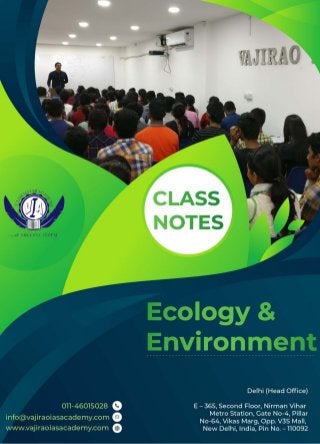
12 Mar 2019 Ecology and Environment Class Notes for UPSC and IAS Preparation; Vajirao IAS Academy Bhubaneswar
- 2. 1 www.vajiraoiasacademy.com, ©Vajirao IAS Academy CLASS NOTE of 12/03/2019 *Please refer to previous notes for better understanding Carbon Cycle— Carbon is a fundamental building block of life. Life on the earth is comprise of carbon based life forms. The geological carbon cycle (Hadean Phase) take place over 100 million of year and involve the cycling of carbon through the various layer of the earth. The biological carbon cycle occur over day, weeks, months, years involve – absorption, conversion and respiration of carbon by living organism. It is the mainly conversion of CO2 from the atmosphere through photosynthesis. Such conversion results production of carbohydrate, glucose that may be converted into other organic compound (Fat, Protein). The remaining carbohydrate not being utilize by the plant, became part of plant tissue. (Net primary productivity). Plant tissue are either being carbon by the herbivores or decompose by the microorganism. Animal consume carbohydrate and release CO2 through respiration. The microorganism decomposes the remaining carbohydrate after the animal die and this carbohydrate oxidized into CO2. Within the ocean large amount of CO2 sink to the ocean flair to be buried into the crust of the earth. Ocean flair CO2 might take 10’s million of years to return to the atmosphere. The stored CO2 in the form of hydrocarbon and after combustion convert in a form of atmospheric CO2. Though deforestation and combustion earth crust CO2 rapidly converted into atmospheric CO2 and this is the primary green house gas responsible for global warming. This gas enhance the green house effect and could result in change in global climate (Change in season, higher global temperature, etc.) – Anthropological activities Nitrogen Cycle— Nitrogen is the most abundant element in the atmosphere and it is the major block of protein, nitric acid such as DNA crucially important component of biological cycle. Atmospheric Nitrogen is the reservoir pool can’t be used by most plant and only leguminous plant. Leguminous plant absorbs N2 in the from of Nitrate N2O and pass through food chain. Ultimately there are released as ammonia when organic material is decomposed. The Ammonia is changed back to nitrate by action of bacteria.
- 3. 2 www.vajiraoiasacademy.com, ©Vajirao IAS Academy If the Nitrate is not absorb by the plants, Atmospheric Nitrogen through rainfall and by teaching penetrate into the soil – Shallow marine sediments and consumed by fish – consumed by pelican birds and dropping of pelican convert into Ammonia. 5 basic process in the Nitrogen Cycle— 1) Nitrogen fixation through leguminous family 2) Nitrification while ammonia can be used by some plant most of the nitrogen take up by plant is converted by bacteria from ammonia, which is highly toxic to many organism then nitrate converts in nitrate. This process is called Nitrification and this bacteria called Nitrifying bacteria. 3) Assimilation – Nitrogen compared an various form (Nitrate, Nitrite, Ammonia, Ammonium) are taken up from soil by plant which synthesis in the form of animal protein. 4) Ammonification – When plants and animal dies the nitrogen in the organic matter reenter into the soil through microorganism decomposition. This decomposition produce ammonia which is then available for other biological process. 5) Denitrification - Nitrogen make its way back into the atmosphere called denitrification. It occurs primarily in wet soils where water make its difficulties for microorganism growth, at here certain organism known as denitrifying bacteria will process nitrate to Oxygen and free nitrogen gas is a byproduct. Phosphorus Cycle— It is the major sedimentary cycle phosphates in the soil are taken in the plant for protein synthesis and pass through food chain. Plant and animal body and there exerts and phosphorous is released to the soil and its can take back into plant or washed out in the ocean. Sulphur Cycle— Sulphur Cycle is a process of collection by which sulphur more into water including living system. Steps of the Sulphur Cycle— Mineralisation or organic sulphur into inorganic sulphur component (H2S) Oxidisation of Hydrogen sulfite convert it into sulfite. Ecological Succession— Ecological Succession is a process of change of species structure of an ecological community over time. Barren — Simple Fung/Biche — Grasses — Shrub — Bruise — Small tree — Big tree Complex (Climax tree/Bisme) – The community begin with relatively few pioneer plant and animal and developed through increasing complexity as a climax community. – After forest fire, severe wind volcanic activities Biome Collapse and Succession that began new habitat and here soil is already developed called Secondary Succession
- 4. 3 www.vajiraoiasacademy.com, ©Vajirao IAS Academy (Faster – Visible – Very important for ecosystem). Further autorotation leads to Second Succession. Biodiversity— Bio – Life Diversity – Variation/Variety Biodiversity depends as temperature, precipitation altitude, soil, geography and the presence of other species. Levels of Biodiversity— 1) Genetic – It refers to the variation of gene within the species. Genetic diversity is essential for a health breeding of population of species. 2) Species diversity – This refers to the variety of species it relates to the numbers of species in a defined area humorous numbers of individual different species and this region represent hotspots of biodiversity. Western Ghats, Eastern Himalaya 3) Ecosystem diversity – The broad different between ecosystem type and diversity of habitat and the ecological process occurring within each ecosystem constitute ecosystem diversity. The boundaries of community and ecosystem are not very rigidly define. – Species divides + genetic diversity + Topography Diversity may be measure at different scales. α – Diversity – It refers to diversity within a particular area/close system / communities / area / Ecosystem. β – Diversity – It is a species diversity between ecosystem. This involve the compare of number taxa that are unique of each ecosystem. Ex-Hotspot γ – Diversity – It is the measurement of overall diversity for different ecosystem within a ecoregion.
